A Rapid Segmentation Method of Highway Surface Point Cloud Data Based on a Supervoxel and Improved Region Growing Algorithm
Abstract
:1. Introduction
2. Related Work
3. Materials and Methods
3.1. Data Denoising Based on Statistical Analysis
3.2. Supervoxel Model Construction
3.3. Improved Region Growing Algorithm Based on Vehicle Trajectory Information
3.3.1. Trajectory Data Calculation
3.3.2. Seed Supervoxel Selection
- The vehicle’s trajectory data and the 3D coordinates of the point cloud are projected onto a 2D plane (XOY) to determine the candidate seed supervoxel dataset {}, as shown in Figure 5.
- The supervoxel with the largest number of points and located in the vehicle trajectory data is selected as the seed supervoxel.
3.3.3. Region Growing
3.4. Road Boundary Optimization Based on Alpha Shape Algorithm
- After applying the region growing segmentation algorithm to the MLS point cloud, there may still be some scattered points or fragments other than road points. These points were traversed and removed based on the point threshold after clustering.
- The Alpha Shape algorithm was used for boundary extraction because it has good shape retention and a faster calculation speed when extracting point cloud road boundaries, and can realize a flexible description and a fast extraction and analysis of point set geometry [37]. The point cloud was projected onto the plane, and delay triangulation was performed on the projected points. For any edge of the triangulation with endpoints and , two circles were drawn with and as the centers and radius of . The coordinates of and are shown in Equations (5) and (6), respectively:where is the vector composed of endpoints and ; is the radius of circle; and are the horizontal and vertical coordinates of the point; and and are the transverse and vertical coordinates of point . As shown in Figure 6, if at least one of the circles does not contain any points from the point set, then the endpoints of that edge are determined to be boundary points.
- After extracting the road contours, it was necessary to perform a smoothing process on the road boundaries. B-spline curves are a type of curve based on polynomial equations that possess strong adaptability, where local point variations do not significantly affect the overall shape of the boundary. They can effectively preserve the local features of the road boundaries. Therefore, B-spline curves were adopted for smoothing [44].
3.5. Experimental Dataset
4. Parameter Setting and Analysis
4.1. Supervoxel Resolution
4.2. Slope Threshold
4.3. Angle Threshold
4.4. Residual Threshold
5. Results and Discussion
5.1. Results
5.1.1. Flat Road Dataset
5.1.2. Sloped Road Dataset
5.2. Discussion
5.3. Road Boundary Optimization Results
6. Conclusions
- In order to solve the problems of redundant and unstructured MLS point cloud data, in this study, we reorganized the original scattered point cloud data through supervoxelization without changing their characteristics. The optimization of this data structure allows for a better differentiation of boundaries between different objects, significantly improving the quality of the target extraction and producing a more complete road surface.
- To address the issue of low accuracy caused by the difficulty in selecting seed points on a road surface extracted using the region growing segmentation algorithm, the proposed algorithm combines the trajectory data of a mobile laser scanning system to enhance the selection strategy of seed voxels in the regional growth algorithm. This integration ensures a high-precision extraction of the road surface.
- The neighborhood definition based on adjacent supervoxels was used in this study to facilitate the calculations of the Euclidean distance and normal vectors and to reduce the need for a time-consuming K-D tree nearest neighbor search for initial point data. This method can quickly and efficiently identify adjacent supervoxels, which can significantly improve the computational efficiency.
Author Contributions
Funding
Institutional Review Board Statement
Informed Consent Statement
Data Availability Statement
Acknowledgments
Conflicts of Interest
References
- De Blasiis, M.R.; Di Benedetto, A.; Fiani, M. Mobile Laser Scanning Data for the Evaluation of Pavement Surface Distress. Remote Sens. 2020, 12, 942. [Google Scholar] [CrossRef]
- Balado, J.; Martínez-Sánchez, J.; Arias, P.; Novo, A. Road Environment Semantic Segmentation with Deep Learning from MLS Point Cloud Data. Sensors 2019, 19, 3466. [Google Scholar] [CrossRef] [PubMed]
- Guan, H.; Li, J.; Yu, Y.; Cha, M.; Cheng, W. Automated Road Information Extraction From Mobile Laser Scanning Data. IEEE Trans. Intell. Transport. Syst. 2015, 16, 194–205. [Google Scholar] [CrossRef]
- Manohar Yadav, A.K.S.; Lohani, B. Extraction of Road Surface from Mobile LiDAR Data of Complex Road Environment. Int. J. Remote Sens. 2017, 38, 4655–4682. [Google Scholar] [CrossRef]
- Mancini, A.; Frontoni, E.; Zingaretti, P. Automatic road object extraction from Mobile Mapping Systems. In Proceedings of the 2012 IEEE/ASME 8th IEEE/ASME International Conference on Mechatronic and Embedded Systems and Applications, Suzhou, China, 8–10 July 2012; pp. 281–286. [Google Scholar]
- Ma, L.; Li, Y.; Li, J.; Wang, C.; Wang, R.; Chapman, M. Mobile Laser Scanned Point-Clouds for Road Object Detection and Extraction: A Review. Remote Sens. 2018, 10, 1531. [Google Scholar] [CrossRef]
- El-Halawany, S.I.; Lichti, D.D. Detecting Road Poles from Mobile Terrestrial Laser Scanning Data. GIScience Remote Sens. 2013, 50, 704–722. [Google Scholar] [CrossRef]
- Wen, J.; Qian, C.; Tang, J.; Liu, H.; Ye, W.; Fan, X. 2D LiDAR SLAM Back-End Optimization with Control Network Constraint for Mobile Mapping. Sensors 2018, 18, 3668. [Google Scholar] [CrossRef] [PubMed]
- Wang, L.; Zhang, Y.; Wang, J. Map-Based Localization Method for Autonomous Vehicles Using 3D-LIDAR. IFAC-PapersOnLine 2017, 50, 276–281. [Google Scholar] [CrossRef]
- Yang, B.; Dong, Z.; Liu, Y.; Liang, F.; Wang, Y. Computing Multiple Aggregation Levels and Contextual Features for Road Facilities Recognition Using Mobile Laser Scanning Data. ISPRS J. Photogramm. Remote Sens. 2017, 126, 180–194. [Google Scholar] [CrossRef]
- Chen, D.; He, X. Fast Automatic Three-Dimensional Road Model Reconstruction Based on Mobile Laser Scanning System. Optik 2015, 126, 725–730. [Google Scholar] [CrossRef]
- Wu, B.; Yu, B.; Huang, C.; Wu, Q.; Wu, J. Automated Extraction of Ground Surface along Urban Roads from Mobile Laser Scanning Point Clouds. Remote Sens. Lett. 2016, 7, 170–179. [Google Scholar] [CrossRef]
- Huang, L.; Chen, S.; Zhang, J.; Cheng, B.; Liu, M. Real-Time Motion Tracking for Indoor Moving Sphere Objects with a LiDAR Sensor. Sensors 2017, 17, 1932. [Google Scholar] [CrossRef] [PubMed]
- Akgul, M.; Yurtseven, H.; Akburak, S.; Demir, M.; Cigizoglu, H.K.; Ozturk, T.; Eksi, M.; Akay, A.O. Short Term Monitoring of Forest Road Pavement Degradation Using Terrestrial Laser Scanning. Measurement 2017, 103, 283–293. [Google Scholar] [CrossRef]
- Kheradmandi, N.; Mehranfar, V. A Critical Review and Comparative Study on Image Segmentation-Based Techniques for Pavement Crack Detection. Constr. Build. Mater. 2022, 321, 126162–126187. [Google Scholar] [CrossRef]
- Yang, M.; Wan, Y.; Liu, X.; Xu, J.; Wei, Z.; Chen, M.; Sheng, P. Laser Data Based Automatic Recognition and Maintenance of Road Markings from MLS System. Opt. Laser Technol. 2018, 107, 192–203. [Google Scholar] [CrossRef]
- Fang, L.; Sun, T.; Wang, S.; Fan, H.; Li, J. A Graph Attention Network for Road Marking Classification from Mobile LiDAR Point Clouds. Int. J. Appl. Earth Obs. Geoinf. 2022, 108, 102735–102741. [Google Scholar] [CrossRef]
- Gehrung, J.; Hebel, M.; Arens, M.; Stilla, U. An approach to extract moving objects from MLS data using a volumetric background representation. ISPRS Ann. Photogramm. Remote Sens. Spat. Inf. Sci. 2017, 4, 107–114. [Google Scholar] [CrossRef]
- Yao, L.; Chen, Q.; Qin, C.; Wu, H.; Zhang, S. Automatic extraction of road markings from mobile laser-point cloud using intensity data. Int. Arch. Photogramm. Remote Sens. Spat. Inf. Sci. 2018, 42, 2113–2119. [Google Scholar] [CrossRef]
- Guan, H.; Yan, W.; Yu, Y.; Zhong, L.; Li, D. Robust Traffic-Sign Detection and Classification Using Mobile LiDAR Data With Digital Images. IEEE J. Sel. Top. Appl. Earth Obs. Remote Sens. 2018, 11, 1715–1724. [Google Scholar] [CrossRef]
- Wang, H.Y.; Luo, H.; Wen, C.L.; Cheng, J.; Li, P.; Chen, Y.P.; Wang, C.; Li, J. Road boundary detection based on local normal saliency from mobile laser scanning data. IEEE Geosci. Remote Sens. Lett. 2015, 12, 2085–2089. [Google Scholar] [CrossRef]
- Cabo, C.; Kukko, A.; García-Cortés, S.; Kaartinen, H.; Hyyppä, J.; Ordoñez, C. An Algorithm for Automatic Road Asphalt Edge Delineation from Mobile Laser Scanner Data Using the Line Clouds Concept. Remote Sens. 2016, 8, 740. [Google Scholar] [CrossRef]
- Balado, J.; Díaz-Vilariño, L.; Arias, P.; González-Jorge, H. Automatic Classification of Urban Ground Elements from Mobile Laser Scanning Data. Autom. Constr. 2018, 86, 226–239. [Google Scholar] [CrossRef]
- Miyazaki, R.; Yamamoto, M.; Hanamoto, E.; Izumi, H.; Harada, K. A Line-Based Approach for Precise Extraction of Road and Curb Region from Mobile Mapping Data. ISPRS Ann. Photogramm. Remote Sens. Spat. Inf. Sci. 2014, 2, 243–250. [Google Scholar] [CrossRef]
- Wu, F.; Wen, C.; Guo, Y.; Wang, J.; Yu, Y.; Wang, C.; Li, J. Rapid localization and extraction of street lightpoles in mobile LiDAR point clouds: A supervoxel-based approach. IEEE Trans.Intell. Transp. Syst. 2017, 18, 292–305. [Google Scholar] [CrossRef]
- Tran, T.H.; Taweep, C. Automated Extraction of Expressway Road Surface from Mobile Laser Scanning Data. J. Cent. South Univ. 2020, 27, 1917–1938. [Google Scholar] [CrossRef]
- Guo, Y.; Wang, H.; Hu, Q.; Liu, H.; Liu, L.; Bennamoun, M. Deep Learning for 3D Point Clouds: A Survey. IEEE Trans. Pattern Anal. Mach. Intell. 2021, 43, 4338–4364. [Google Scholar] [CrossRef]
- Saovana, N.; Yabuki, N.; Fukuda, T. Automated Point Cloud Classification Using an Image-Based Instance Segmentation for Structure from Motion. Autom. Constr. 2021, 129, 103804. [Google Scholar] [CrossRef]
- Su, H.; Maji, S.; Kalogerakis, E.; Learned-Miller, E. Multi-View Convolutional Neural Networks for 3D Shape Recognition. In Proceedings of the 2015 IEEE International Conference on Computer Vision (ICCV), Santiago, Chile, 7–13 December 2015; pp. 945–953. [Google Scholar]
- Yang, Z.; Wang, L. Learning Relationships for Multi-View 3D Object Recognition. In Proceedings of the 2019 IEEE/CVF International Conference on Computer Vision (ICCV), Seoul, Republic of Korea, 27 October–2 November 2019; pp. 7504–7513. [Google Scholar]
- Qi, C.R.; Su, H.; Mo, K.; Guibas, L.J. Pointnet: Deep learning on point sets for 3d classification and segmentation. In Proceedings of the IEEE Conference on Computer Vision and Pattern Recognition, Honolulu, Hl, USA, 21–26 July 2017; pp. 652–660. [Google Scholar]
- Qi, C.R.; Yi, L.; Su, H.; Guibas, L.J. Pointnet++: Deep hierarchical feature learning on point sets in a metric space. In Proceedings of the 31st International Conference on Neural Information Processing Systems (NIPS 2017), Long Beach, CA, USA, 4–9 December 2017; pp. 5105–5114. [Google Scholar]
- Thomas, H.; Qi, C.R.; Deschaud, J.-E.; Marcotegui, B.; Goulette, F.; Guibas, L.J. Kpconv: Flexible and deformable convolution fo rpoint clouds. In Proceedings of the IEEE International Conference on Computer Vision, Seoul, Republic of Korea, 27 October–2 November 2019; pp. 6411–6420. [Google Scholar]
- Hu, Q.; Yang, B.; Xie, L.; Rosa, S.; Guo, Y.; Wang, Z.; Trigoni, N.; Markham, A. Randla-net: Efficient semantic segmentation of large-scale point clouds. In Proceedings of the IEEE Conference on Computer Vision and Pattern Recognition, Seattle, WA, USA, 16–18 June 2020; pp. 11108–11117. [Google Scholar]
- Wang, Y.; Sun, Y.; Liu, Z.; Sarma, S.E.; Bronstein, M.M.; Solomon, J.M. Dynamic Graph CNN for Learning on Point Clouds. ACM Trans. Graph. 2019, 38, 146. [Google Scholar] [CrossRef]
- Zhu, Z.; Li, X.; Xu, J.; Yuan, J.; Tao, J. Unstructured Road Segmentation Based on Road Boundary Enhancement Point-Cylinder Network Using LiDAR Sensor. Remote Sens. 2021, 13, 495. [Google Scholar] [CrossRef]
- Gao, B.; Xu, A.; Pan, Y.; Zhao, X.; Yao, W.; Zhao, H. Off-Road Drivable Area Extraction Using 3D LiDAR Data. In Proceedings of the 2019 IEEE Intelligent Vehicles Symposium (IV), Paris, France, 9–12 June 2019; pp. 1505–1511. [Google Scholar]
- Zai, D.; Li, J.; Guo, Y.; Cheng, M.; Lin, Y.; Luo, H.; Wang, C. 3-D Road Boundary Extraction From Mobile Laser Scanning Datavia Supervoxels and Graph Cuts. IEEE Trans. Intell. Transp. Syst. 2018, 19, 802–813. [Google Scholar] [CrossRef]
- Rusu, R.B.; Marton, Z.C.; Blodow, N.; Dolha, M.; Beetz, M. Towards 3D Point Cloud Based Object Maps for Household Environments. Robot. Auton. Syst. 2008, 56, 927–941. [Google Scholar] [CrossRef]
- CloudCompare; Version 2.13; GNU General Public License, [EB/OL]. Available online: https://www.gnu.org/licenses/gpl-3.0.html (accessed on 17 February 2024).
- Papon, J.; Abramov, A.; Schoeler, M.; Worgotter, F. Voxel Cloud Connectivity Segmentation-Supervoxels for Point Clouds. In Proceedings of the 2013 IEEE Conference on Computer Vision and Pattern Recognition, Portland, OR, USA, 23–28 June 2013; IEEE: Portland, OR, USA, 2013; pp. 2027–2034. [Google Scholar]
- Lin, Y.; Wang, C.; Zhai, D.; Li, W.; Li, J. Toward Better Boundary Preserved Supervoxel Segmentation for 3D Point Clouds. ISPRS J. Photogramm. Remote Sens. 2018, 143, 39–47. [Google Scholar] [CrossRef]
- Aït-Sahalia, Y.; Xiu, D. Principal Component Analysis of High-Frequency Data. J. Am. Stat. Assoc. 2019, 114, 287–303. [Google Scholar] [CrossRef]
- Wirges, S.; Rösch, K.; Bieder, F.; Stiller, C. Fast and Robust Ground Surface Estimation from LIDAR Measurements Using Uniform B-Splines. arXiv 2022, arXiv:2203.01180. [Google Scholar]
- Cao, Y.; Wang, Y.; Xue, Y.; Zhang, H.; Lao, Y. FEC: Fast Euclidean Clustering for Point Cloud Segmentation. Drones 2022, 6, 325. [Google Scholar] [CrossRef]
- Fischler, M.A.; Bolles, R.C. Random Sample Consensus: A Paradigm for Model Fitting with Applications to Image Analysis and Automated Cartography. In Readings in Computer Vision; Elsevier: Amsterdam, The Netherlands, 1987; pp. 726–740. [Google Scholar]
- Ma, X.; Luo, W.; Chen, M.; Li, J.; Yan, X.; Zhang, X.; Wei, W. A Fast Point Cloud Segmentation Algorithm Based on Region Growth. In Proceedings of the 2019 18th International Conference on Optical Communications and Networks (ICOCN), Huangshan, China, 5–8 August 2019; pp. 1–2. [Google Scholar]
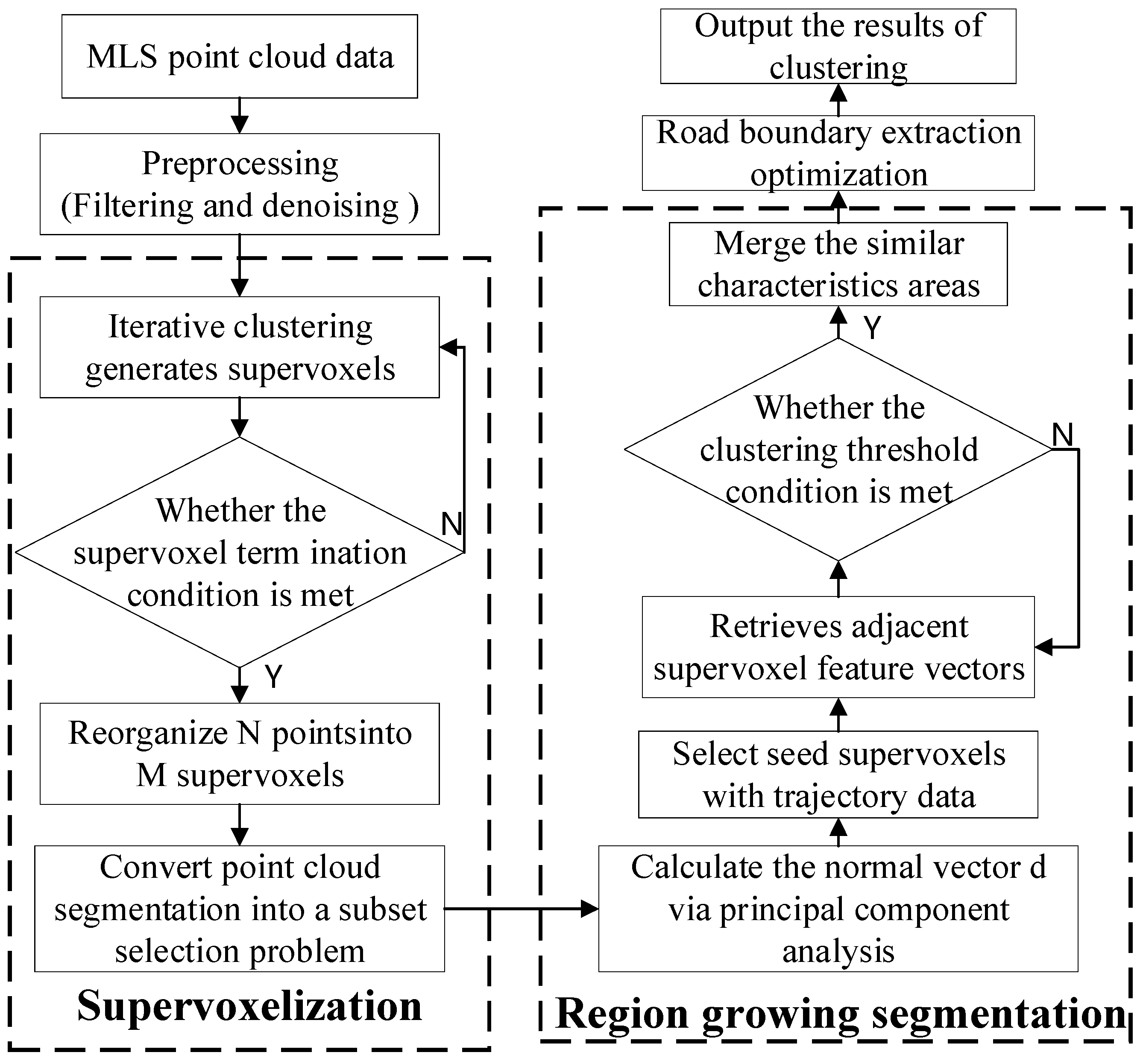

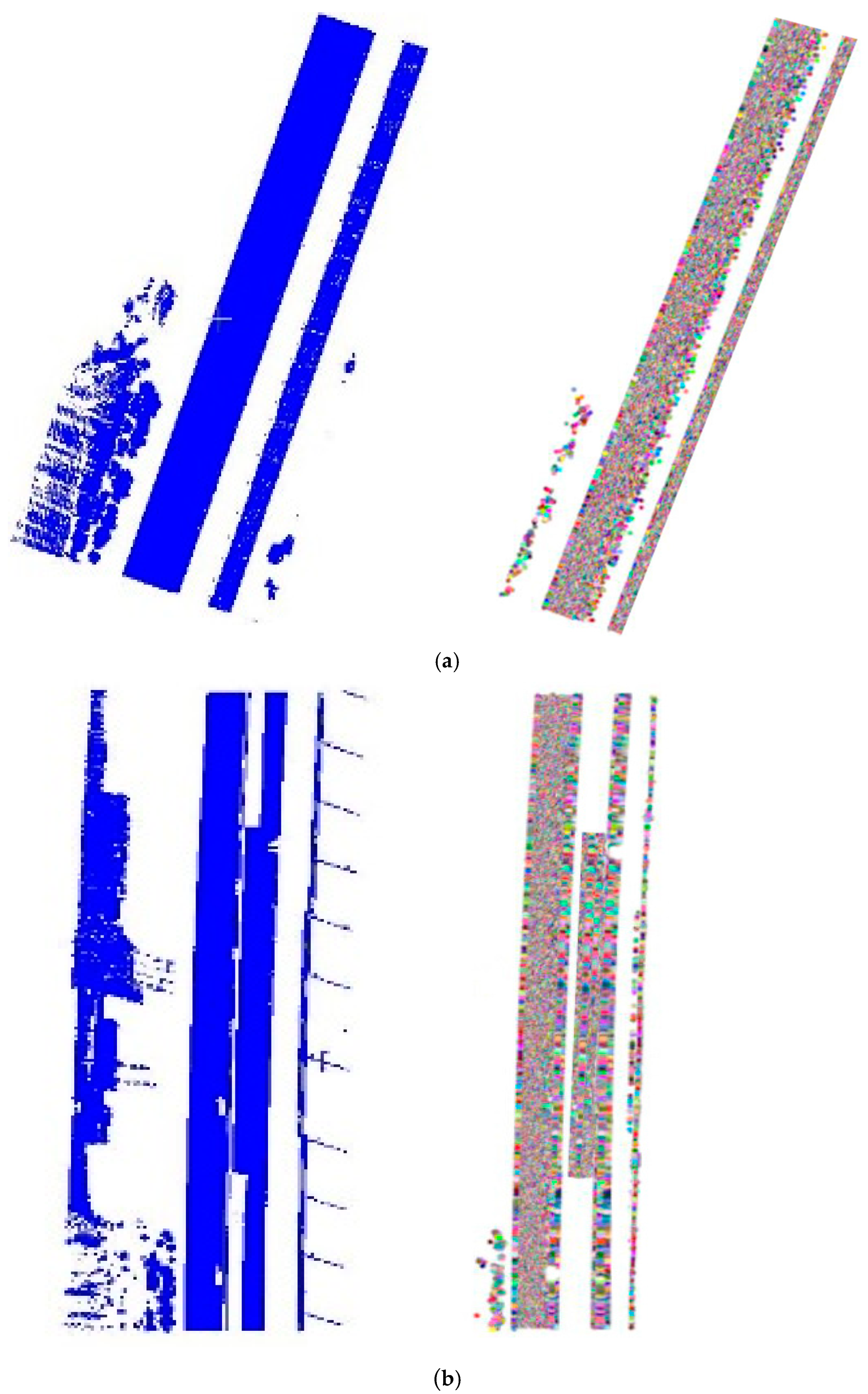
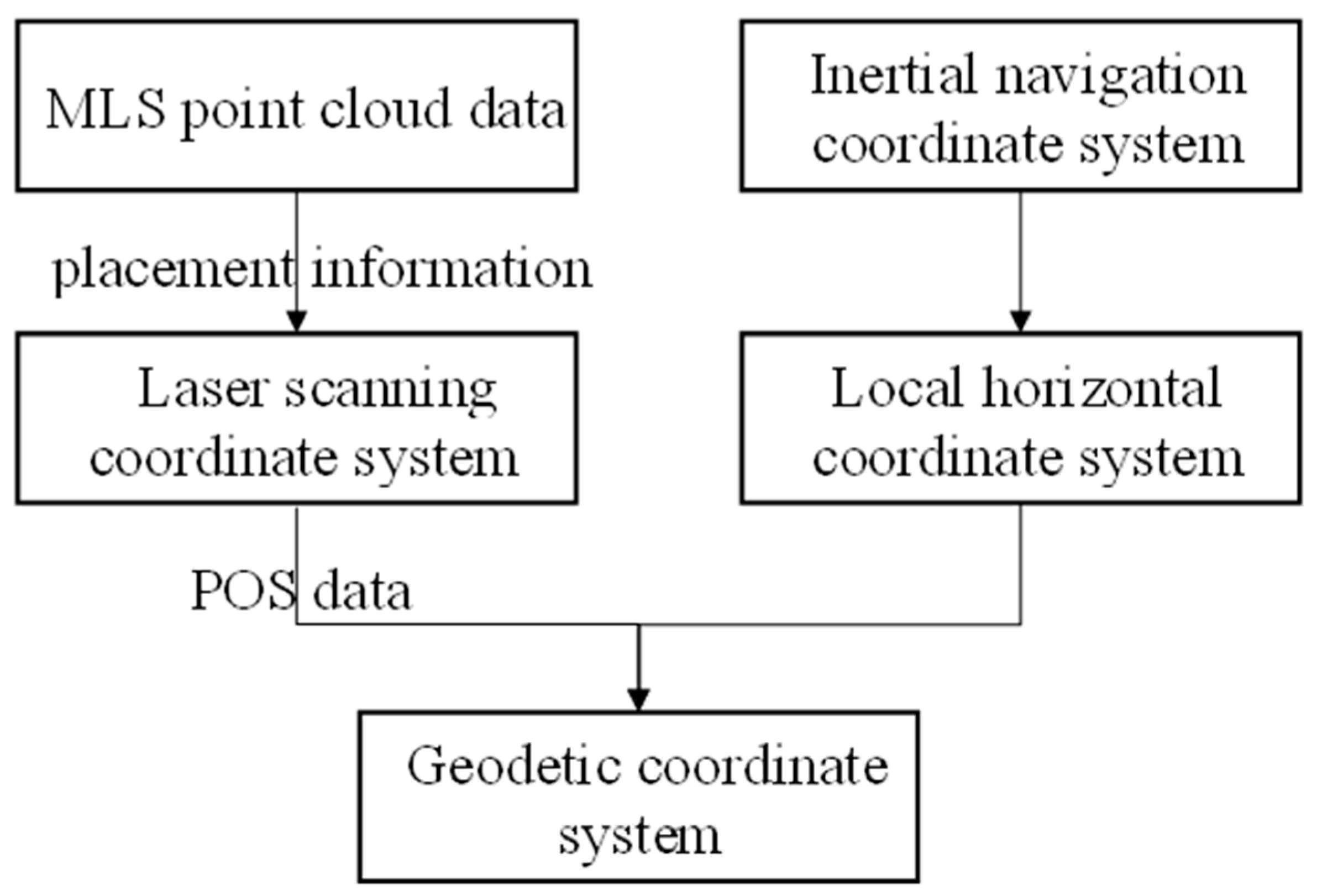


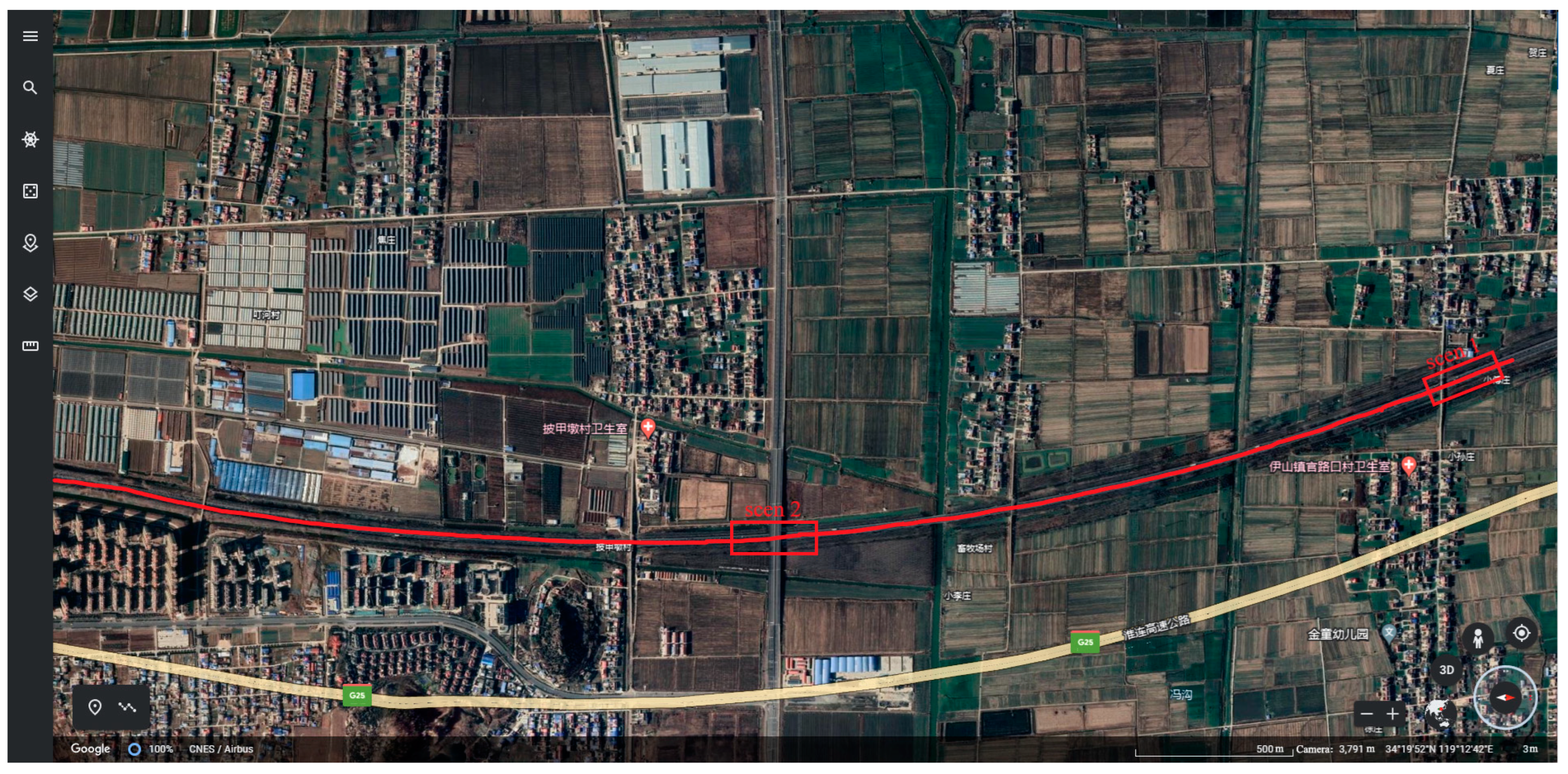
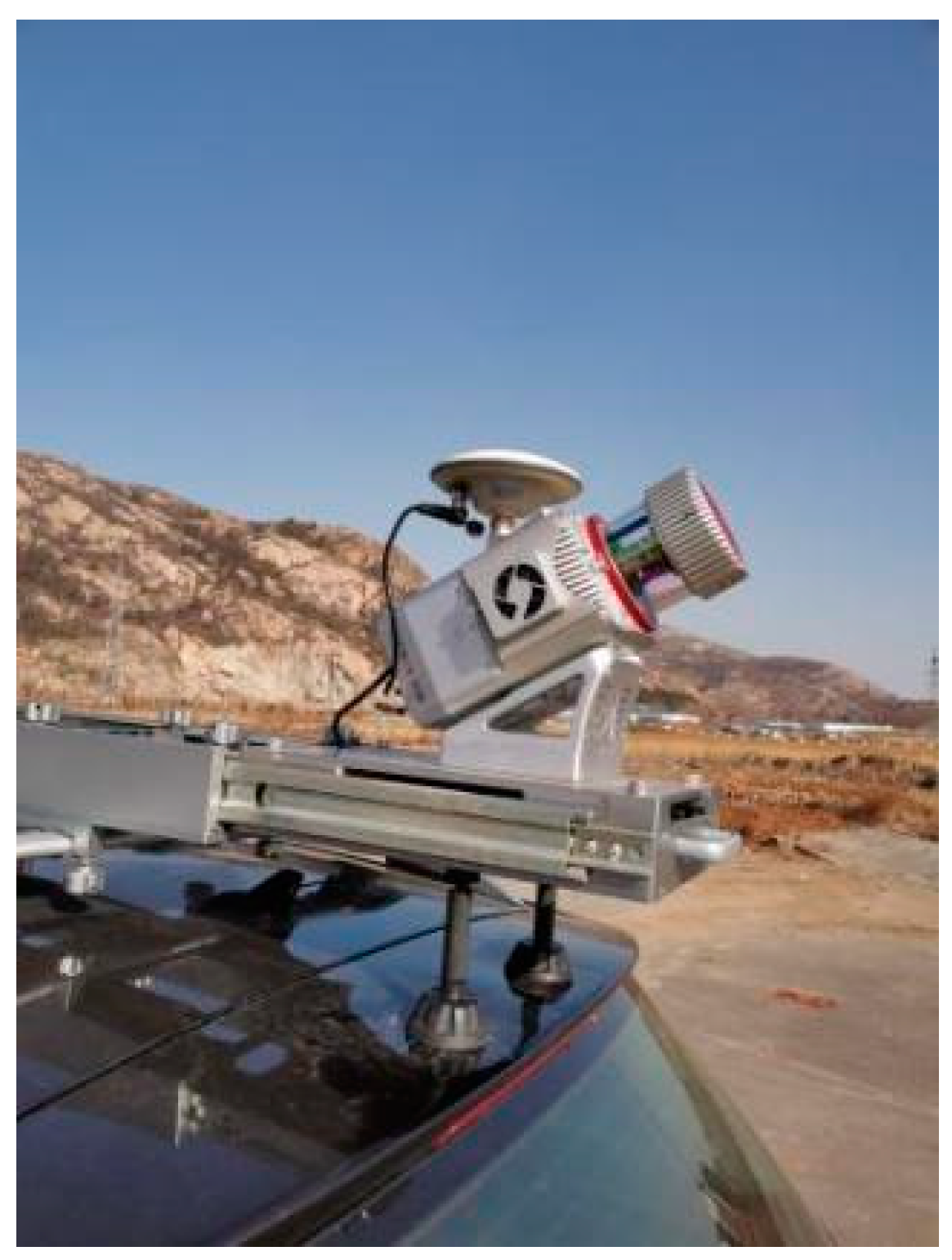


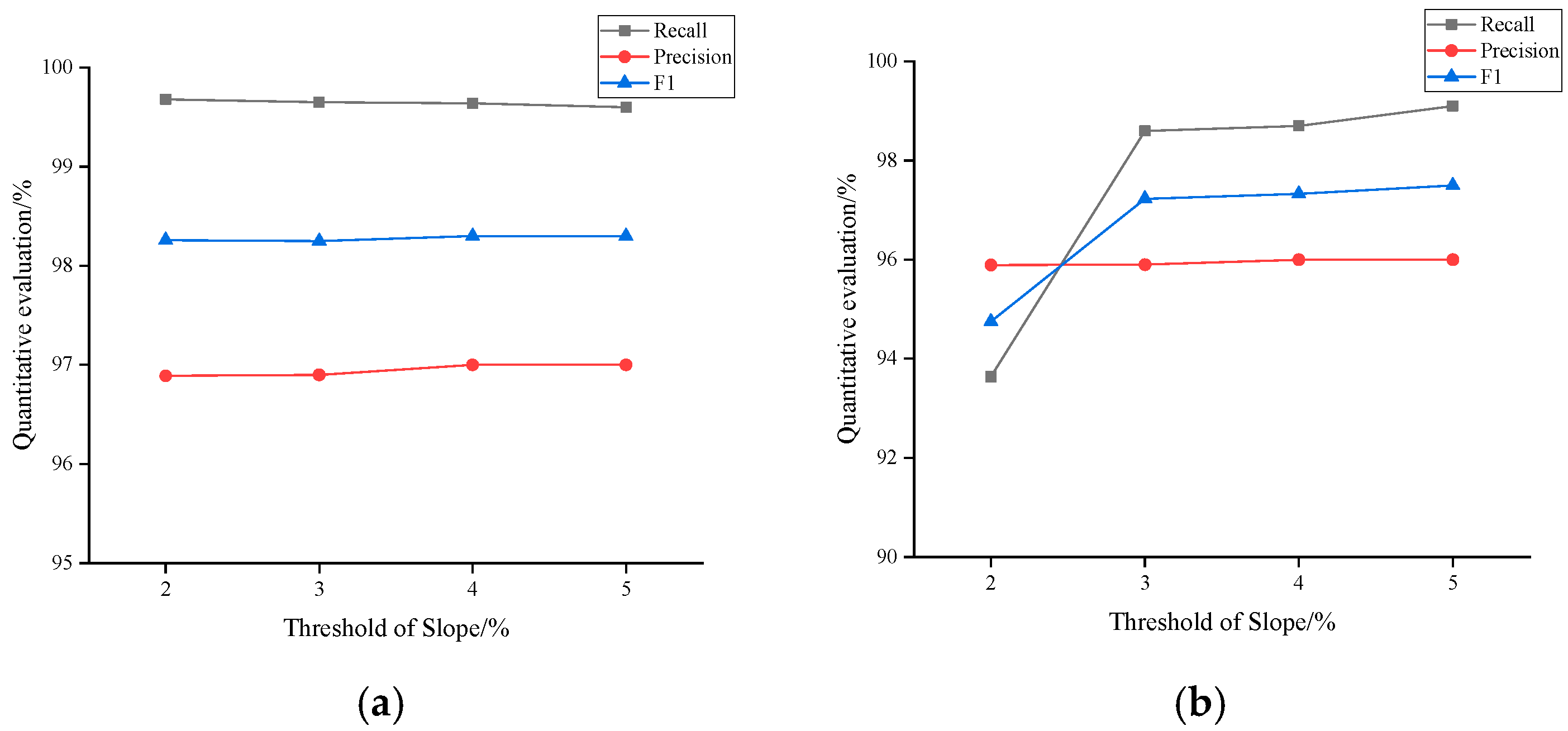




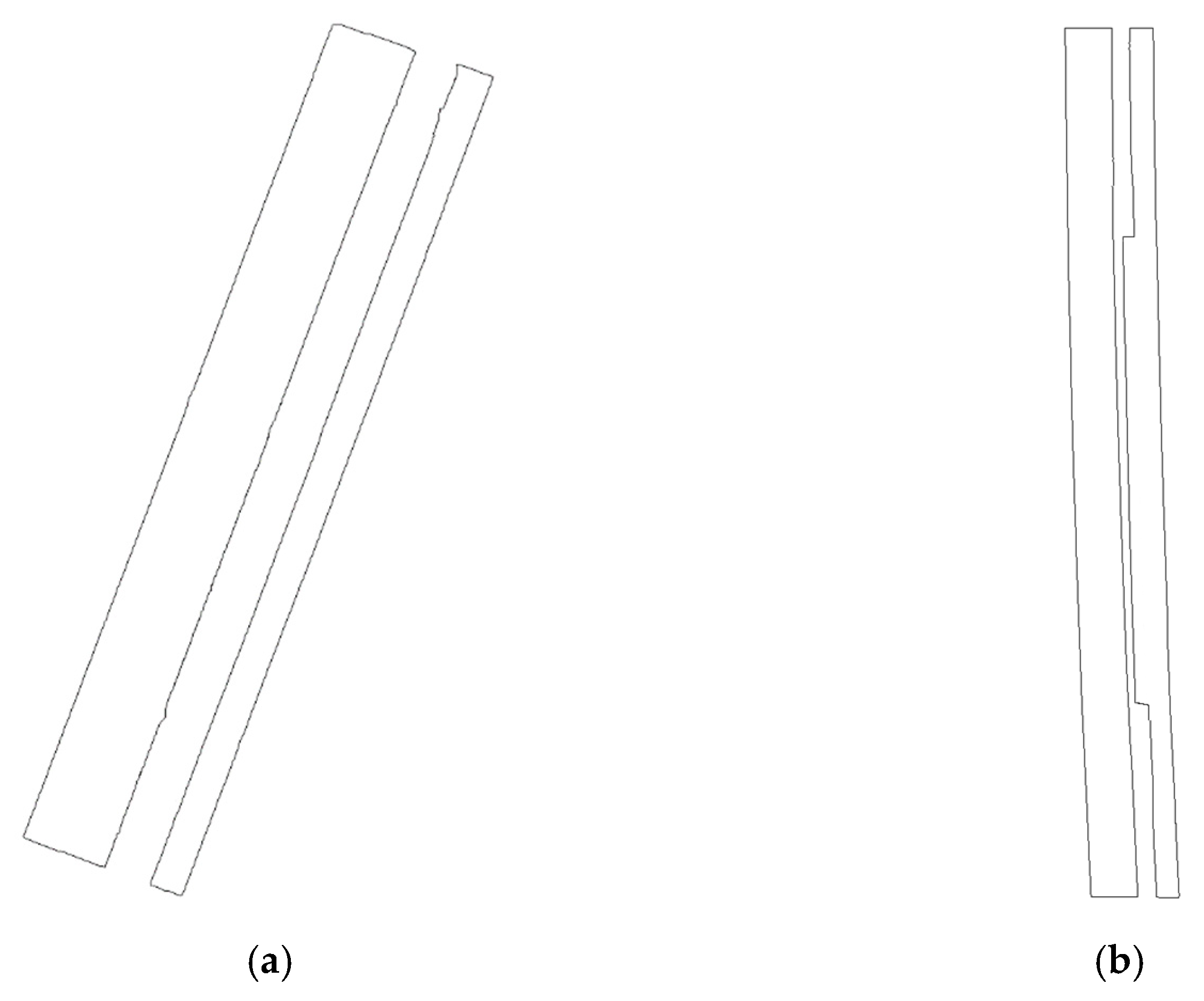
| Indicator Parameters | Performance Specifications |
|---|---|
| Precision | Horizontal: <0.05 mRMS Vertical: <0.05 mRMS |
| Minimum ranging | 5 m |
| Laser field of view | The range of 0°–330° is adjustable |
| Inertial navigation update rate | 200 Hz |
| Gyroscope bias stability | <0.05°/h |
| Gyroscope range | ±490°/s |
| Accelerometer range | ±10 g |
| Post-processing attitude | Roll/Pitch:0.005 |
| accuracy | Heading: 0.017 |
| Post-processing position | Horizontal: 0.01 m |
| accuracy | Elevation: 0.02 m |
| Indicator Parameters | Performance Specifications |
|---|---|
| Gyro input range (max) | ±490°/s |
| Gyro bias stability (25 °C) | ≤0.1°/h(max) ≤0.05°/h(typical) |
| Gyro scale factor (maximum input range, 25 °C) | ≤50 ppm |
| Gyro angle random walk (25 °C) | 0.012°/√h (≤0.7°/h/√h) |
| Accelerometer range (max) | ±10 g |
| Accelerometer bias stability (constant temperature) | <0.05 mg |
| Accelerometer velocity walks randomly | ≤0.12 mg/√h(0.23 ft/s/√h) |
| Name | Configuration |
|---|---|
| Processor | AMD Ryzen 5 5600H (AMD, Santa Clara, CA, USA) |
| Graphics card | NVIDIA GeForce GTX 1650 (NVIDIA, Santa Clara, CA, USA) |
| Run memory | 8 GB |
| Parameters | Supervoxel Resolution/m | Slope Threshold/% | Angle Threshold/° | Residual Threshold/m |
|---|---|---|---|---|
| Flat road dataset | 0.2 | 5 | 5 | 0.2 |
| Sloped road dataset | 0.2 | 5 | 5 | 0.2 |
| Algorithms | Number of Point Clouds | Supervoxelization/s | Partition/s | Total Time/s |
|---|---|---|---|---|
| Euclidean clustering-based segmentation | 3,975,648 | / | 253 | 253 |
| RANSAC-based segmentation | 3,975,648 | / | 284 | 284 |
| Traditional region growing-based segmentation | 3,975,648 | / | 307 | 307 |
| Improved region growing algorithm | 3,975,648 | 18 | 130 | 148 |
| Algorithms | Number of Point Clouds | Supervoxelization/s | Partition/s | Total Time/s |
|---|---|---|---|---|
| Euclidean clustering-based segmentation | 4,815,042 | / | 315 | 315 |
| RANSAC-based segmentation | 4,815,042 | / | 344 | 344 |
| Traditional region growing-based segmentation | 4,815,042 | / | 399 | 399 |
| Improved region growing algorithm | 4,815,042 | 23 | 141 | 164 |
| Experimental Scenarios | Road Surface Points | Detected Road Surface Points | TP | FN | FP | Recall/% | Precision/% | F1/% |
|---|---|---|---|---|---|---|---|---|
| Flat road | 3,483,979 | 3,576,981 | 3,470,824 | 13,155 | 106,157 | 99.6 | 97.0 | 98.3 |
| Sloped road | 4,304,106 | 4,468,155 | 4,242,854 | 61,252 | 225,301 | 98.5 | 94.9 | 96.7 |
| Average | 99.1 | 96.0 | 97.5 |
Disclaimer/Publisher’s Note: The statements, opinions and data contained in all publications are solely those of the individual author(s) and contributor(s) and not of MDPI and/or the editor(s). MDPI and/or the editor(s) disclaim responsibility for any injury to people or property resulting from any ideas, methods, instructions or products referred to in the content. |
© 2024 by the authors. Licensee MDPI, Basel, Switzerland. This article is an open access article distributed under the terms and conditions of the Creative Commons Attribution (CC BY) license (https://creativecommons.org/licenses/by/4.0/).
Share and Cite
Zhao, W.; Ning, Y.; Jia, X.; Chai, D.; Su, F.; Wang, S. A Rapid Segmentation Method of Highway Surface Point Cloud Data Based on a Supervoxel and Improved Region Growing Algorithm. Appl. Sci. 2024, 14, 2852. https://doi.org/10.3390/app14072852
Zhao W, Ning Y, Jia X, Chai D, Su F, Wang S. A Rapid Segmentation Method of Highway Surface Point Cloud Data Based on a Supervoxel and Improved Region Growing Algorithm. Applied Sciences. 2024; 14(7):2852. https://doi.org/10.3390/app14072852
Chicago/Turabian StyleZhao, Wenshuo, Yipeng Ning, Xiang Jia, Dashuai Chai, Fei Su, and Shengli Wang. 2024. "A Rapid Segmentation Method of Highway Surface Point Cloud Data Based on a Supervoxel and Improved Region Growing Algorithm" Applied Sciences 14, no. 7: 2852. https://doi.org/10.3390/app14072852







